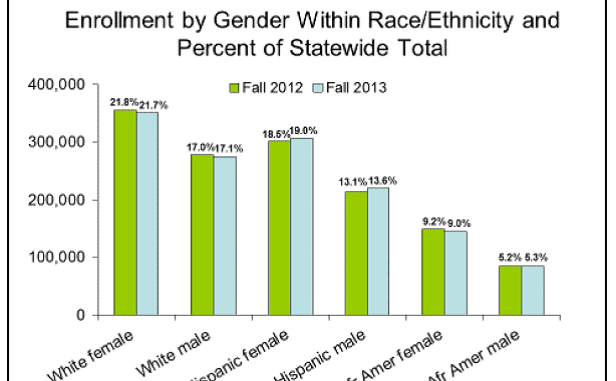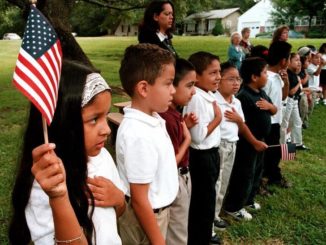
By Alex Gonzalez
The most recent “2014 Progress Report” by Texas Higher Education Coordination Board (THECB) paints a cautious projection for Higher Education Enrollments in the state. The report shows that in 2014, Enrollment in Higher Education decreased by 2,000 among Hispanics and about 4,000 for “whites” per semester. Among whites, this drop is the fourth consecutive year, more than 20,000 students by 2014.
The heads of Higher Ed in Texas are arguing that the role of Texas legislature in this create a dialogue that has to be about where we want Texas to be and how competitive we want Texas to be in higher education, in all our institutions; especially the goal to develop research centers in Texas whiting universities to be able compete with others states.
The conservative Texas Senate, led by Dan Patrick, is considering terminating the Dream Act signed by Gov. Perry. But that will add even more pressure for some Hispanics student to drop, or not enroll, due to high cost, and thereby increasing the “Gap” to enroll a total of 630,000 student by 2015; enrollment growth has slowed in recent years and fell by nearly 14,000 students in fall 2013. see figure 1
 Texas Higher Coordination Board goal is, by 2015, close the gaps in participation rates to add 630,000 more students. The statewide enrollment target – to add 630,000 students by 2015 – is based on enrollment reaching 5.7 percent of the projected population for 2015.
Texas Higher Coordination Board goal is, by 2015, close the gaps in participation rates to add 630,000 more students. The statewide enrollment target – to add 630,000 students by 2015 – is based on enrollment reaching 5.7 percent of the projected population for 2015.
Increased participation is the first step toward increasing student success and reaping the benefits of closing the gaps in higher education. Targets for the participation goal were set so that, by fall 2015, enrollment in higher education at public, independent, and career institutions would be 5.7 percent of the Texas population (all ages) for each of four categories: Statewide, Hispanic, African American and White.
 According to targets set by THECB, Texas will need to enroll approximately 27,000 more students in both fall 2014 and 2015 at public, independent, and career institutions to meet the goal. On average, more than 44,000 students have been added each year since all 2000, but enrollment growth has slowed in recent years and fell by nearly 14,000 students in fall 2013.
According to targets set by THECB, Texas will need to enroll approximately 27,000 more students in both fall 2014 and 2015 at public, independent, and career institutions to meet the goal. On average, more than 44,000 students have been added each year since all 2000, but enrollment growth has slowed in recent years and fell by nearly 14,000 students in fall 2013.
the 2014 Report also underlines that:
Enrollment at public two-year institutions fell by over 12,000 students in fall 2013, the second straight drop. Career school enrollment was down almost 10,000 students. Public four-year institutions (including health-related institutions) tempered some of the loss by adding more than 8,000 students to their headcount.
African Americans reached the final enrollment target in fall 2009, six years before the final deadline. African Americans continued to add more students every year thereafter, except for a drop of about 4,500 students in fall 2013. Despite the drop, this population remained far above the 2015 target. Hispanics and whites, however, are not on track to reach their final targets. Hispanic enrollment growth is decelerating with only 11,000 students added in fall 2013 and white enrollment dropped for the fourth consecutive year by the largest drop ever, more than 20,000 students. see figure 6

In this year’s (2014) progress report, fall 2012 and 2013 enrollment data use one -year-old career school figures as proxies for statewide tabulations, as well as for breakouts by gender, ethnicity, and so forth. The content found in the appendices also uses these data. Prior to fall 2012, the two-year-old career school data are still used. For all years, and for all levels of aggregation and appendices, including baseline student counts, flex-entry enrollment (student enrollment that occurs after the class census date) has been added. These adjustments were introduced in the 2013 CTG progress report.
Thus, tampering with bills that have worked, or repealing the Texas Dream Act, will be counter-productive for Texas enrollments and bad policy, as the conservative business community (TAB), University of Texas System Chancellor William McRaven and Speaker Joe Straus are arguing. Moreover, the state economic needs to graduate “a critical mass,” as it was ruled by the Supreme Court in 2014 in Fisher v. the University of Texas. The ruling was not in favor of Affirmative Action, but rather to give more time to University of Texas to achieve “critical mass” numbers, or the 5.7 percent estimated by the THECB.
 And that is the principle objective of the Texas Higher Coordination Board goal, close the “gaps” in enrollment rates and add 630,000 students from all “ethnic” and racial groups in the state. However, enrollments are now down, and this deficit is even worse among “whites.”
And that is the principle objective of the Texas Higher Coordination Board goal, close the “gaps” in enrollment rates and add 630,000 students from all “ethnic” and racial groups in the state. However, enrollments are now down, and this deficit is even worse among “whites.”
Similar concerns have being raised by former state Comptroller Susan Combs. Combs noted that we are running we will beading with wow to support a growing number of retirees with a smaller working-age population. Thus it is imperative that we educate a young Texans to meet the future demands for services by an aging population.
The report argues that:
An estimated 26,500 to 42,300 Texans are currently on waiting lists for adult education programs. Among adults without a high school diploma, state funding for adult education in 2010 was $4.83 per capita in Texas, compared with $106.27 in California. The report calls on the state to increase funding for the programs and streamline the process to reduce waiting lists.
As early college high school programs rapidly expand in the coming school year in Texas, the report urges funding for closer examination and further growth if they’re proven successful. The programs offer at-risk students alternative education to receive a high school diploma and an associate’s degree or credit toward a bachelor’s by the time they finish high school.
So the Legislature should work and passing bills to improve enrollment so the state can meets its “critical mass” or the 5.7 percent targets by THECB. But it should not pass bill, or repeal, that will exacerbate enrollment projections.
 Alex Gonzalez is a political Analyst and Political Director for Latinos Ready To Vote! comments to [email protected]
Alex Gonzalez is a political Analyst and Political Director for Latinos Ready To Vote! comments to [email protected]




